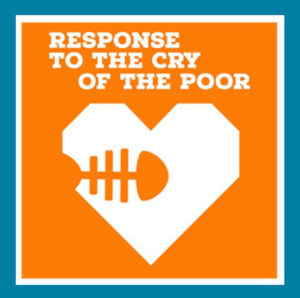By Sister Kathy Schmittgens
“The Response to the Cry of the Poor is a call to promote eco-justice,
aware that we are called to defend human life from conception to death,
and all forms of life on Earth. Actions could include projects to promote
solidarity, with special attention given to vulnerable groups such as indigenous
communities, refugees, migrants, and children at risk, analysis and
improvement of social systems, and social service programmes.”
– The Laudato Si’ Goal – Response to the Cry of the Poor

There are two significant injustices that people who are poor are experiencing due to the climate crisis. The first is that they are usually the first whose lives are disrupted by extreme weather events that are increasing in both intensity and frequency. For instance, floods and hurricanes in some areas, extreme drought, and loss of crop production in others. They are the ones who usually carry out a subsistence living with no social safety net, no insurance, and no savings.
According to a report at the World Bank:
Climate change is deeply intertwined with global patterns of inequality. The poorest and most vulnerable people bear the brunt of climate change impacts yet contribute the least to the crisis. As the impacts of climate change mount, millions of vulnerable people face disproportionate challenges in terms of extreme events, health effects, food, water, and livelihood security, migration and forced displacement, loss of cultural identity, and other related risks.
https://www.worldbank.org/en/topic/social-dimensions-of-climate-change
As is also indicated in the quote above, the second injustice is that they are not the ones contributing to the crisis to any extent. They are not the biggest consumers.
“A true ‘ecological debt’ exists, particularly between the global north and south, connected to commercial imbalances with effects on the environment, and the disproportionate use of natural resources by certain countries over long periods of time and so they are not contributing to the increase in greenhouse gases.” (LS 51)
This debt is not confined to climate events alone. Irresponsible waste disposal from industry and agricultural sources is causing imbalances in quality of life, particularly in poorer communities.
These imbalances are also seen in our own country. Consider the Flint, Michigan water contamination crisis. Forty-five percent of the residents of Flint lived below the poverty line. In a cost cutting measure, the source of the city water was changed from Lake Michigan to the Flint River. The change caused water pipes to leach lead and various other contaminants. Nearly 9,000 children were supplied with lead-contaminated water for 18 months. (https://www.nrdc.org/stories/flint-water-crisis-everything-you-need-know#summary)
In this age of NIMBY (Not In My Back Yard), wealthier areas are able to mount legal cases against anything they consider causing harm to their neighborhoods. But there is not the expertise nor the finances for poorer communities to do the same. So, these communities are the most vulnerable to environmental impacts.
For many developed countries, areas of poverty are seen as ideal “dumping spots” for contaminated byproducts of production. Due to lax environmental laws, natural resources are exploited, once again disturbing the ecosystems on which local people depend.
One only has to look at the Amazon rainforest and see the willful deforestation. This imbalance has many ramifications, as sources of livelihood are lost or polluted, many see the only chance for survival in migration.
“There has been a tragic rise in the number of migrants seeking to flee from the growing poverty caused by environmental degradation. They are not recognized by international conventions as refugees; they bear the loss of the lives they have left behind, without enjoying any legal protection whatsoever. Sadly, there is widespread indifference to such suffering, which is even now taking place throughout our world.” (LS 25)
We see a domino effect that traps the poorest, most vulnerable populations. The Cry of the Poor is loud and yet many choose not to listen. During an October 6, 2022, press conference, CRS announced that it is launching its “One Planet, One People” Campaign to engage the U.S. Catholic community more fully on climate change. The campaign attempts to educate Catholics on how climate change is severely impacting people today and is expected only to worsen in years to come. Read about the CRS campaign here: https://www.ncronline.org/earthbeat/justice/catholic-relief-services-campaign-aims-engageus-catholics-climate-change
Creighton University and the Catholic Climate Covenant have been offering webinars on the Laudato Si’ Action Plan Goals. You can find their webinar on the Response to the Cry of the Poor at: https://youtu.be/r5CepRW6Hns This webinar offers a reflective theological foundation for this goal by Daniel Castillo, PhD
More on Laudato Si’
- Read more reflections about the Laudato Si’ Action Platform goals.
- Click here to learn more about Laudato Si’ and the seven international goals of the Laudato Si’ Action Platform.
